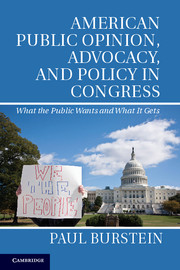5 - The Impact of Advocacy on Congressional Action
Published online by Cambridge University Press: 05 June 2014
Summary
How strongly does advocacy affect policy change? Very strongly, say some. That interest groups strongly affect policy is conventional wisdom, and it is now seemingly taken for granted that social movement organizations, formerly seen as powerless because they represent political outsiders, often have substantial policy impact as well (e.g., McAdam and Su 2002:716). There are many reasons for this: interest organizations control resources useful to politicians; their members care intensely about their issues, in contrast to the generally indifferent public; they are often able to manipulate the information available to politicians; and so on (see, e.g., Dahl 1956; Jones 1994; Kollman 1998; Lohmann 1993; Wright 1996). The image of lobbyists dominating the legislative process is a staple of American political discourse (Leech 2010).
Not strongly at all, argue others. We wouldn’t expect advocacy to have much impact because in key approaches to democratic theory, the most important determinant of policy change will be public opinion. Politicians need votes to win elections, so the public has the ultimate authority over policy. Making this point especially strongly, Lohmann (1993:319) has written that “it is puzzling that rational political leaders with majoritarian incentives would ever respond to political action” by interest organizations.
- Type
- Chapter
- Information
- American Public Opinion, Advocacy, and Policy in CongressWhat the Public Wants and What It Gets, pp. 107 - 129Publisher: Cambridge University PressPrint publication year: 2014

